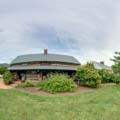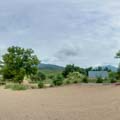The original 1,400-acre parcel land for Pharsalia Plantation was given to William Massie and his bride, Sarah Steptoe, in 1814 as a wedding gift from William’s father, Major Thomas Massie. The main house that William and Sarah lived in was built by enslaved workers from 1814 to 1816. One of the men who built the house was George, a carpenter that William bought for $743 at the 1809 Public Auction of the Jas W. Harvies Estate. On March 3, 1816, about the time William took permanent residence at Pharsalia, there were already twenty-one enslaved people living and working there to get the house and property in order for Massie’s arrival. These twenty-one people were: Chester, Jefse, Peter, Martian, Otho, Julius, Hicks, Randolph, Jacob, Dave, Black Milley, Myra, Rachel, Nancy, Nanny, Stephen, Ursaley, John, Dinah, Poll, and Bet.
Pharsalia Plantation was an efficiency driven plantation. William Massie spent his whole career as a planter devoted to acquiring more land to enable him to use his enslaved work force to its maximum productivity. At the height of his landholdings, in 1859, he owned 9,725 acres and “62 hands were worked [in the fields]…of all sorts, & sizes,” each earning Massie an average income of $81.47 for that year. In addition to being a large-scale planter, Massie was also a slave breeder, trader, barterer, and owner. He kept meticulous records about farming and finances—crop records, orchard records, weather records, slave accounts, cash books, numerous memorandum books, annual financial summaries—as well as detailed records about enslaved people. He kept a “Slave Register” and a book he called the “Negro Book.” Massie received enslaved people as a wedding present from both his father and his father-in-law, James Steptoe. He received so many enslaved people in 1815 that he started the Slave Register that year, an annual practice that he continued until his death in 1862. The Slave Register documented the names, ages, and birthdates of all the enslaved people he owned. It also documented how they were acquired, if/when they were sold, and why. Occasionally it also listed the parents and when and how someone died. The Negro Book detailed bartering and trading activities with enslaved people.
Everything about Pharsalia Plantation demonstrated Massie’s desire for efficiency. Massie kept his soils fertile by enforcing a strict policy of crop rotation. He laid out his plantations in radial designs that were complementary to crop rotations. The auxiliary buildings he had built on the property assisted in his other profit-making businesses. For example, the slave hospital and the nursery are two spaces that would have been critically important to his slave-breeding business. Therefore, in the main house of Pharsalia he put the nursery, now the modern kitchen, at the back of the house directly across from the slave hospital for easy access between the two. Girls as young as fourteen years old were forced to start having children and could spend the next thirty years giving birth every one or two years. The higher the survival rate of their births, the longer they were used for breeding purposes by the Massie family.
At the time of his death in 1862, William owned 154 enslaved people according to the inventory completed by the County Court of Nelson County on August 25 of that year. According to the 1860 census, he also owned twenty-five slave houses. The names of the people he owned and who farmed his lands and cared for him and his family were: Warner, Jacke, Andy, Scott, Ransom, Bartlette, Matthew, Jonah, Riley, Hannah, Rachel, George (miller), Julius Buff, Matilda, Biddie, Elleck, Pack, Delphia, Kyle (very infirm), Suckey, Burrel, Frederick, Beckey, Adam, Charles, Nancy, Pomphey, Diley, Roderick, Elva, Charlotte, Squire, Lizza & child, Elias, Barbary, Emanuel, Jack, Warwick, Arthur, Daniel (a cripple), Julius (blacksmith), Sallie, Elvira, Cornelia, Clara, Eliza, Libby, Tom, Jane, Cezar, Soloman, Polina, Catharine, Silia, Reubin, Paul, Bettie, Allice, Emma, Moses, Jacob, Abe, Lidda, Synthia, Jim, Kitty, Sam, Amanda, Aaron, Ciss, Henry, Patience, Aida, John, Dick Vaughan, Anderson, Franky, Betsey, Sandy, Harvey, Joshua (diseased), Martha, Tarlton, Winston, Billy, Louisa, Washington, Brown, Dinah, Cato, Preston (wheelwright), Susan, Milford, Harriet, Bella, Braxton (blacksmith), Julia Ann, Phillis, Clifford, Mosley, Dan (carpenter), Ciller, Howard, Fred, Albert, Rhoda & child, Hunter, Joe, Bowling, Isaiah, Monroe, Madison, Mitchell, Patrick, Edward, Meredith, Mary, Grace, Jessee, Ginny, Hopkins (sore leg), Aggy & Girl, Venus, Frank, Silas, Adaline, Wesley, Wyatt, Milly, Lewis, Belinda, Edmund, Martha Ellen, Matilda, Hannah, Jane, Robertson, Juddy, Foster, Jake, Maria, Dave, Fannie, Egypt, Jerry, Richard, Virgin & child, Foster, Tandy, Florence, and Peter.
Twenty-five houses would not have been enough space to house all 154 enslaved people. Additional buildings at Pharsalia, also listed on the inventory, that may have been used as living space for enslaved people include: the Main House, New Lumber House, Old Lumber House, Weaving House, Daphne, Lime House, Cookery [Kitchen], Carriage House, Laundry, Hospital, Apple House, Blacksmith Shop and Shelter, Cooper’s Shop, Mill at Pharsalia, Coal House, and Stable Shed. Today, four of the houses (log Slave House, framed Slave House, brick Kitchen-Hospital-Quarter, and Weaving House) that enslaved individuals lived and worked in still exist in varying conditions on the Pharsalia landscape. Also standing is the main house, an ice house, a privy, smokehouse, barns, and stables.
After William Massie’s death, his land and enslaved people were divided among his widow, Maria C. Massie, and his children. Maria got Pharsalia and 733.25 acres of land. Pharsalia passed to her children after her death in 1889. In February 1893, Pharsalia was sold out of the family. For the next sixty years it only changed hands twice before returning back to descendants of the Massie family on May 2, 1952, where it has remained.
Pharsalia Plantation is on private property and is now a rental venue for weddings and other events. The kitchen space of the Kitchen-Hospital-Quarter is interpreted and open to all visitors. The two extant slave houses are closed to the public but have a sign outside identifying them as such.




